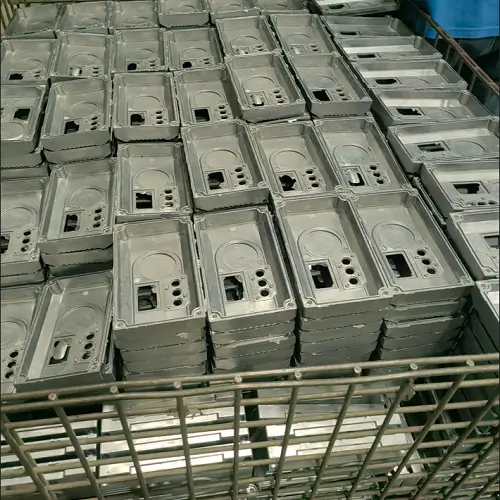Bead blasting is a surface treatment technique that uses high-speed spherical abrasive particles (such as glass, ceramic, or plastic beads) to clean, polish, or texture a material’s surface. Unlike traditional sandblasting, which uses sharp abrasives (such as sand or aluminum oxide), bead blasting uses round particles. This key difference makes it gentler and able to create a uniform satin finish without corroding or damaging the base material.
You can think of it as giving a metal part a high-pressure “exfoliation”: instead of roughly scraping off material, bead blasting uses gentle impacts of particles to smooth the surface. Bead blasting is the preferred method in precision fields like medical implants, high-end electronics, and aerospace components.

How Does Bead Blasting Work?
The core principle of bead blasting is the precise coordination between air pressure and abrasive flow. The breakdown of the process is explained below:
Equipment activation: The bead blasting machine (usually a closed bead blasting cabinet) uses compressed air to accelerate the abrasive beads through a blasting gun.
Impact stage: High-speed particles strike the workpiece, removing contaminants, oxides, or burrs.
Final effect: On a microscopic level, the spherical particles reshape the surface, forming a uniform non-reflective texture.
By adjusting air pressure, bead size, and spray angle, we control the results of bead blasting. Low pressure with fine beads achieves a soft finish, suitable for precision parts; high pressure with coarse beads can tackle tougher tasks, such as removing old paint layers from engine components.
Bead Blasting Equipment and Tools
Blasting cabinet: A sealed working chamber equipped with gloves and viewing windows, used for safe operation and abrasive recovery.
Blasting gun: The “magic wand” that guides the particle flow, like a high-pressure water jet for surface treatment.
Protective equipment: Goggles, gloves, and respirators protect the operator from particle intrusion.
Types of Abrasives:
Glass beads: Reusable, suitable for stainless steel or aluminum.
Ceramic beads: Highly durable, often used for heavy-duty tasks.
Plastic beads: Gentle texture, suitable for soft metals or plastics.
Advantages and Disadvantages of Bead Blasting
Visual aesthetics: Creates a uniform matte finish loved by designers.
Surface preparation: Removes rust, oxides, and old coatings without easily deforming parts.
Deburring function: Smooths sharp edges on CNC machined parts.
Environmental attributes: Glass/ceramic beads can be reused multiple times.
Disadvantages / Limitations
Not suitable for soft plastics: Intense blasting may cause polymers to melt or deform.
Time-consuming: Large parts may require hours of detailed processing.
Depth limitation: Unlike machining, bead blasting only affects the surface layer.
Comparison of Bead Blasting with Other Surface Finishing Methods: How Does It Perform Among Similar Processes?
Traditional sandblasting: Uses sharp abrasives to forcefully strip material, leaving a rough texture—beneficial for coating adhesion, but too aggressive for precise surfaces.
Vapor blasting: Combines water with abrasives for dust-free cleaning, often used for complex parts, but has limited application scenarios.
Chemical etching: Corrodes material with acid solutions, offering high precision but involving hazardous chemicals and waste treatment.
Bead blasting balances various needs: flexible, environmentally friendly, and delivers both tactile and visual appeal.
Typical Applications of Bead Blasting
CNC machined parts: Removes machining marks on aluminum, titanium, or brass parts.
Stainless steel products: Adds corrosion resistance and anti-fingerprint surface to appliances, surgical instruments, and architectural panels.
Aerospace: Prepares surfaces of engine parts for coating.
Medical instruments: Polishes implants and tools to reduce bacterial growth.
Consumer electronics: Gives smartphones, watches, and automotive trims a premium matte texture.
Practical Tips for Achieving the Best Bead Blasting Results
Surface pretreatment: Clean oil and impurities with solvents; dirty surfaces may cause uneven processing.
Precisely control air pressure: Start with low pressure (30–50 PSI) and test on scrap material; high pressure may create dents.
Choose the appropriate bead size:
Fine beads (100–170 microns): For delicate surfaces.
Coarse beads (200+ microns): For quick material removal.
Maintain consistent operation: Keep the blasting gun at a stable angle and distance from the workpiece (15–30 cm) to ensure uniform texture.
Bead Blasting FAQ
Is bead blasting safe?
Yes—when operated in a sealed environment with proper personal protective equipment (PPE), the blasting cabinet effectively isolates particles.
How long does bead blasting take?
It depends on part size and desired effect: a small CNC bracket may take only 10 minutes, while a large turbine blade may require several hours.
Can plastic or soft metals be bead blasted?
Yes, but plastic beads or reduced air pressure must be used to avoid damage.
Which is better, bead blasting or traditional sandblasting?
Bead blasting is suited for fine processing, while traditional sandblasting focuses on powerful cleaning. Choose based on your needs.
Conclusion
At Jeek, we have over a decade of experience in bead blasting treatment. Through our advanced bead blasting services, we ensure that your parts are not only up to standard but also more aesthetically pleasing. Learn more about our surface treatment services now—let us transform your raw components into precise works of art. Click to get a quote from Jeek.


